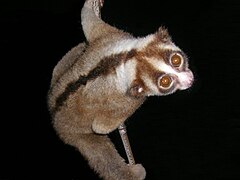Lorisinae
podrodzina ssaków naczelnych
Lorisinae – podrodzina ssaków z rodziny lorisowatych (Lorisidae).
| Lorisinae | |||||
| J.E. Gray, 1821[1] | |||||
 Przedstawiciele rodziny – kukang jawajski (Nycticebus javanicus) | |||||
| Systematyka | |||||
| Domena | |||||
|---|---|---|---|---|---|
| Królestwo | |||||
| Typ | |||||
| Podtyp | |||||
| Gromada | |||||
| Infragromada | |||||
| Rząd | |||||
| Podrząd | |||||
| Infrarząd | |||||
| Rodzina | |||||
| Podrodzina |
Lorisinae | ||||
| Typ nomenklatoryczny | |||||
|
Loris É. Geoffroy Saint-Hilaire, 1796 | |||||
| |||||
| Rodzaje | |||||
| |||||
Zasięg występowania edytuj
Podrodzina obejmuje gatunki występujące w południowej i południowo-wschodniej Azji[14].
Podział systematyczny edytuj
Do podrodziny należą następujące występujące współcześnie rodzaje[15][14][16]:
- Loris É. Geoffroy Saint-Hilaire, 1796 – lori
- Xanthonycticebus Nekaris & Nijman, 2022
- Nycticebus É. Geoffroy Saint-Hilaire, 1812 – kukang
Opisano również rodzaje wymarłe:
- Microloris Flynn & Morgan, 2005[17]
- Nycticeboides Jacobs, 1981[18]
Uwagi edytuj
Przypisy edytuj
- ↑ a b J.E. Gray. On the Natural Arrangment of Vertebrose Animals. „The London Medical Repository”. 15, s. 298, 1821. (ang.).
- ↑ J.E. Gray. An Outline of an Attempt at the Disposition of Mammalia into Tribes and Families, with a List of the Genera apparently appertaining to each Tribe. „Annals of Philosophy”. New Series. 10, s. 338, 1825. (ang.).
- ↑ J.E. Gray. Revision of the species of lemuroid animals, with the description of some new species. „Proceedings of the Zoological Society of London”. 1863, s. 132, 1863. (ang.).
- ↑ St.G.J. Mivart. Notes on the crania and dentition of the Lemuridae. „Proceedings of the Zoological Society of London”. 1864, s. 643, 1864. (ang.).
- ↑ J.V. Carus: Handbuch der Zoologie. Cz. 1: Wirbelthiere, Mollusken und Molluscoiden. Leipzig: Wilhelm Engelmann, 1868, s. 116. (niem.).
- ↑ J.E. Gray: Catalogue of Monkeys, Lemurs, and Fruit-eating Bats in the collection of the British Museum. London: The Trustees, 1870, s. 69. (ang.).
- ↑ H.A. Nicholson: A manual of zoology for the use of students: with a general introduction on the principles of zoology. Cz. 2. Edinburgh: Blackwood, 1870, s. 553. (ang.).
- ↑ W.H. Flower & R. Lydekker: An introduction to the study of mammals living and extinct. London: A. and C. Black, 1891, s. 691. (ang.).
- ↑ a b H. Winge: Jordfundne og nulevende aber (Primates) fra Lagoa Santa, Minas Geraes, Brasilien: med udsigt over pungdyrenes slægtskab. F. Dreyer: Kjøbenhavn, 1895, s. 20, seria: E. Museo Lundii. (duń.).
- ↑ W.K. Gregory. I. On the relationship of the Eocene lemur Notharctus to the Adapidae and to other primates: II. On the classification and phylogeny of the Lemuroidea. „Geological Society of America Bulletin”. 26 (1), s. 436, 1915. (ang.).
- ↑ Ch.T. Regan. The evolution of the Primates. „The Annals and Magazine of Natural History”. Tenth series. 6 (34), s. 384, 1930. DOI: 10.1080/00222933008673231. (ang.).
- ↑ J.H. Schwartz: Primate systematics and a classification ofthe order. W: D. Swindler & J. Erwin (redaktorzy): Comparative primate biology. Cz. 1: Ssystematics, evolution and anatomy. New York: Alan R. Liss, 1986, s. 31. ISBN 978-0-8451-4000-0. (ang.).
- ↑ a b M.C. McKenna & S.K. Bell: Classification of mammals above the species level. Nowy Jork: Columbia University Press, 1997, s. 334. ISBN 978-0-231-11013-6. (ang.).
- ↑ a b C.J. Burgin, D.E. Wilson, R.A. Mittermeier, A.B. Rylands, T.E. Lacher & W. Sechrest: Illustrated Checklist of the Mammals of the World. Cz. 1: Monotremata to Rodentia. Barcelona: Lynx Edicions, 2020, s. 168–170. ISBN 978-84-16728-34-3. (ang.).
- ↑ N. Upham, C. Burgin, J. Widness, M. Becker, C. Parker, S. Liphardt, I. Rochon & D. Huckaby: Treeview of Mammalian Taxonomy Hierarchy. [w:] ASM Mammal Diversity Database (Version 1.11) [on-line]. American Society of Mammalogists. [dostęp 2023-09-09]. (ang.).
- ↑ Nazwy polskie za: W. Cichocki, A. Ważna, J. Cichocki, E. Rajska-Jurgiel, A. Jasiński & W. Bogdanowicz: Polskie nazewnictwo ssaków świata. Warszawa: Muzeum i Instytut Zoologii PAN, 2015, s. 33–34. ISBN 978-83-88147-15-9. (pol. • ang.).
- ↑ L.J. Flynn & M.E. Morgan: New lower primates from the Miocene Siwaliks of Pakistan. W: D.E. Lieberman, R.J. Smith & J. Kelley (redaktorzy): Interpreting the past: Essays on human, primate, and mammal evolution in honor of David Pilbeam. Boston: Brill Academic Publishers, 2005, s. 101. ISBN 978-03-91-04247-6. (ang.).
- ↑ L.L. Jacobs. Miocene lorisid primates from the Pakistan Siwaliks. „Nature”. 289 (5798), s. 586, 1981. DOI: 10.1038/289585a0. (ang.).